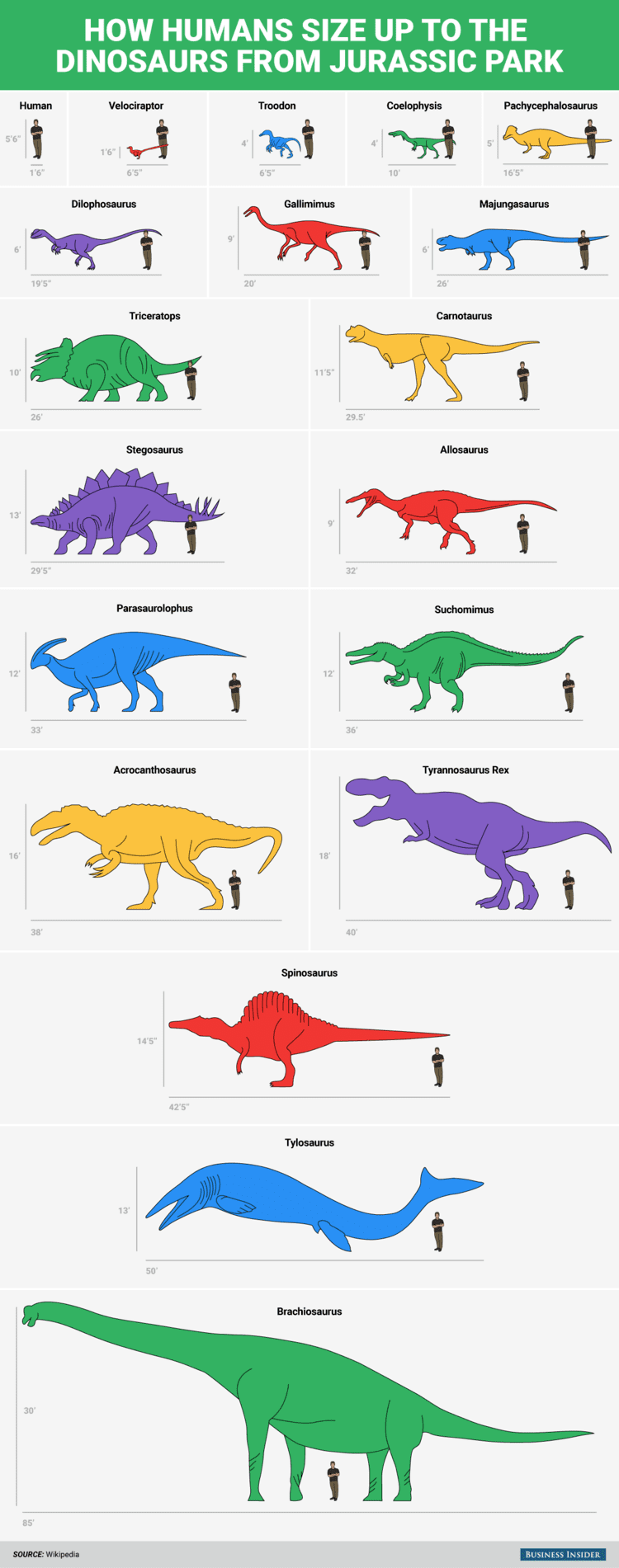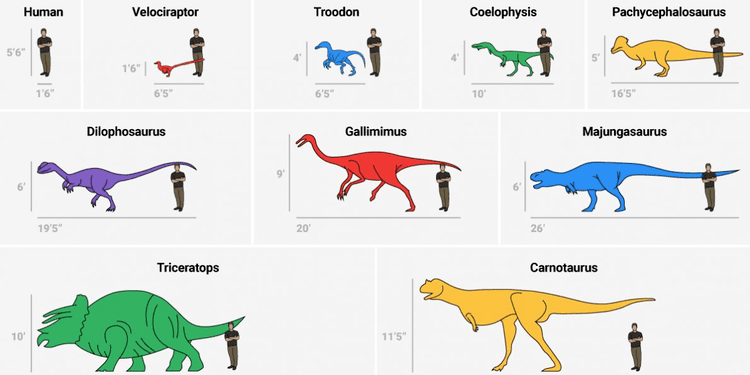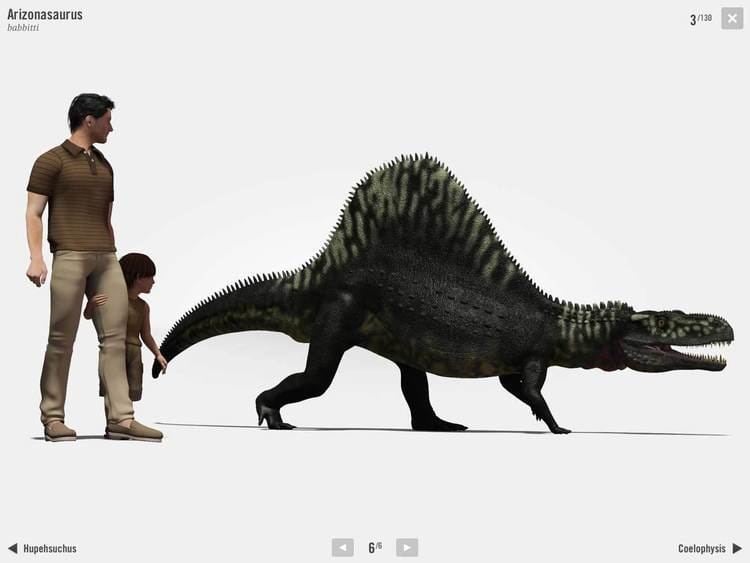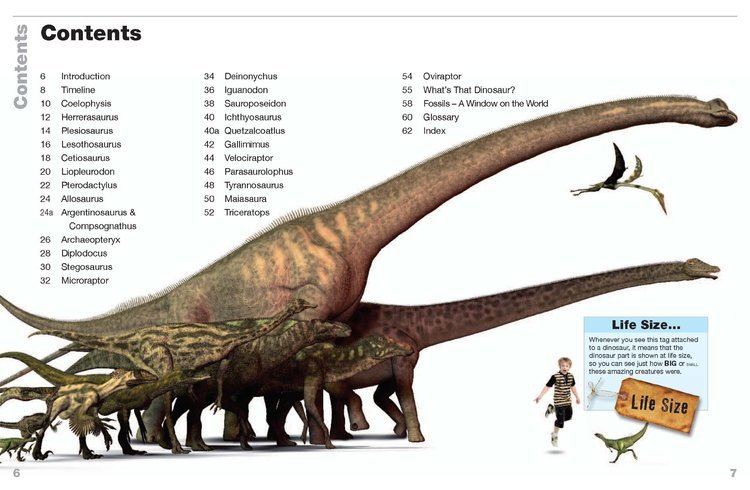 | ||
Dinosaur size comparison
Size has been one of the most interesting aspects of dinosaur science to the general public and to scientists. Dinosaurs show some of the most extreme variations in size of any land animal group, ranging from the tiny hummingbirds, which can weigh as little as three grams, to the extinct titanosaurs, which could weigh as much as 70 tonnes (69 long tons; 77 short tons).
Contents
- Dinosaur size comparison
- Jurassic park dinosaur size vs real size
- Record sizes
- Sauropodomorphs
- Heaviest sauropodomorphs
- Longest sauropodomorphs
- Shortest sauropods
- Lightest sauropods
- Lightest non sauropod sauropodomorphs
- Shortest non sauropod sauropodomorphs
- Theropods
- Heaviest theropods
- Longest theropods
- Lightest theropods
- Shortest theropods
- Shortest non avialan theropods
- Lightest non avialan theropods
- Longest ornithopods
- Heaviest ornithopods
- Shortest ornithopods
- Lightest ornithopods
- Longest ceratopsians
- Heaviest ceratopsians
- Shortest ceratopsians
- Lightest ceratopsians
- Longest pachycephalosaurs
- Shortest pachycephalosaurs
- Longest thyreophorans
- Heaviest thyreophorans
- Shortest thyreophorans
- Lightest thyreophorans
- References

Scientists will probably never be certain of the largest and smallest dinosaurs to have ever existed. This is because only a tiny percentage of animals ever fossilize, and most of these remain buried in the earth. Few of the specimens that are recovered are complete skeletons, and impressions of skin and other soft tissues are rare. Rebuilding a complete skeleton by comparing the size and morphology of bones to those of similar, better-known species is an inexact art, and reconstructing the muscles and other organs of the living animal is, at best, a process of educated guesswork. Weight estimates for dinosaurs are much more variable than length estimates, because estimating length for extinct animals is much more easily done from a skeleton than estimating weight. Estimating weight is most easily done with the laser scan skeleton technique that puts a "virtual" skin over it, but even this is only an estimate.

Current evidence suggests that dinosaur average size varied through the Triassic, early Jurassic, late Jurassic and Cretaceous periods. Predatory theropod dinosaurs, which occupied most terrestrial carnivore niches during the Mesozoic, most often fall into the 100- to 1,000-kilogram (220 to 2,200 lb) category when sorted by estimated weight into categories based on order of magnitude, whereas recent predatory carnivoran mammals peak in the 10- to 100-kilogram (22 to 220 lb) category. The mode of Mesozoic dinosaur body masses is between one and ten metric tonnes. This contrasts sharply with the size of Cenozoic mammals, estimated by the National Museum of Natural History as about 2 to 5 kg (4.4 to 11.0 lb).
Jurassic park dinosaur size vs real size
Record sizes

The sauropods were the largest and heaviest dinosaurs. For much of the dinosaur era, the smallest sauropods were larger than anything else in their habitat, and the largest were an order of magnitude more massive than anything else that has since walked the Earth. Giant prehistoric mammals such as Paraceratherium and Palaeoloxodon (the largest land mammals ever) were dwarfed by the giant sauropods, and only modern whales surpass them in size. There are several proposed advantages for the large size of sauropods, including protection from predation, reduction of energy use, and longevity, but it may be that the most important advantage was dietary. Large animals are more efficient at digestion than small animals, because food spends more time in their digestive systems. This also permits them to subsist on food with lower nutritive value than smaller animals. Sauropod remains are mostly found in rock formations interpreted as dry or seasonally dry, and the ability to eat large quantities of low-nutrient browse would have been advantageous in such environments.

One of the tallest and heaviest dinosaurs known from good skeletons is Giraffatitan brancai (previously classified as a species of Brachiosaurus). Its remains were discovered in Tanzania between 1907 and 1912. Bones from several similar-sized individuals were incorporated into the skeleton now mounted and on display at the Museum für Naturkunde Berlin; this mount is 12 metres (39 ft) tall and 21.8–22.5 metres (72–74 ft) long, and would have belonged to an animal that weighed between 30,000 to 60,000 kilograms (66,000 to 132,000 lb). One of the longest complete dinosaurs is the 27-metre-long (89 ft) Diplodocus, which was discovered in Wyoming in the United States and displayed in Pittsburgh's Carnegie Natural History Museum in 1907.

There were larger dinosaurs, but knowledge of them is based entirely on a small number of fragmentary fossils. Most of the largest herbivorous specimens on record were discovered in the 1970s or later, and include the massive titanosaur Argentinosaurus huinculensis, which is the largest dinosaur known from uncontroversial evidence, estimated to have been 96.4 metric tons (106.3 short tons) and 39.7 m (130 ft) long. Some of the longest sauropods were those with exceptionally long, whip-like tails, such as the 33.5-metre-long (110 ft) Diplodocus hallorum (formerly Seismosaurus) and the 33- to 34-metre-long (108–112 ft) Supersaurus. The tallest was the 18-metre-tall (59 ft) Sauroposeidon.
Tyrannosaurus was for many decades the largest theropod and best-known to the general public. Since its discovery, however, a number of other giant carnivorous dinosaurs have been described, including Spinosaurus, Carcharodontosaurus, and Giganotosaurus. The original Spinosaurus specimens (as well as newer fossils described in 2006) support the idea that Spinosaurus is larger than Tyrannosaurus, showing that Spinosaurus was possibly 6 metres longer and at least 1 metric ton heavier than Tyrannosaurus, though Tyrannosaurus, Therizinosaurus and Deinocheirus were among the tallest of the theropods. There is still no clear explanation for exactly why these animals grew so much larger than the land predators that came before and after them.
The largest extant theropod is the common ostrich, up to 2.74 metres (9 ft 0 in) tall and weighs between 63.5 and 145.15 kilograms (140.0 and 320.0 lb).
The smallest non-avialan theropod known from adult specimens may be Anchiornis huxleyi, at 110 grams (3.9 ounces) in weight and 34 centimetres (13 in) in length. However, some studies suggest that Anchiornis was actually an avialan. The smallest dinosaur known from adult specimens which is definitely not an avialan is Parvicursor remotus, at 162 grams (5.7 oz) and measuring 39 centimetres (15 in) long. When modern birds are included, the bee hummingbird Mellisuga helenae is smallest at 1.9 g (0.067 oz) and 5.5 cm (2.2 in) long.
Recent theories propose that theropod body size shrank continuously over the past 50 million years, from an average of 163 kilograms (359 lb) down to 0.8 kg (1.8 lb), as they eventually evolved into modern birds. This is based on evidence that theropods were the only dinosaurs to get continuously smaller, and that their skeletons changed four times faster than those of other dinosaur species.
Sauropodomorphs
Sauropodomorph size is difficult to estimate given their usually fragmentary state of preservation. Sauropods are often preserved without their tails, so the margin of error in overall length estimates is high. Mass is calculated using the cube of the length, so for species in which the length is particularly uncertain, the weight is even more so. Estimates that are particularly uncertain (due to very fragmentary or lost material) are preceded by a question mark. Each number represents the highest estimate of a given research paper. One large sauropod, Amphicoelias fragillimus, was based on particularly scant remains that have been lost since their description by paleontologists in 1878. Analysis of the illustrations included in the original report suggested that A. fragillimus may have been the largest land animal of all time, weighing up to 100–150 t (110–170 short tons) and measuring between 40–60 m (130–200 ft) long. However, later analysis of the surviving evidence, and the biological plausibility of such a large land animal, suggested that the enormous size of this animal was an over-estimate due partly to typographical errors in the original report.
Generally, the giant sauropods can be divided into two categories: the shorter but stockier and more massive forms (mainly titanosaurs and some brachiosaurids), and the longer but slenderer and more light-weight forms (mainly diplodocids).
Because different methods of estimation sometimes give conflicting results, mass estimates for sauropods can vary widely causing disagreement among scientists over the accurate number. For example, the titanosaur Dreadnoughtus was originally estimated to weigh 59.3 tonnes by the allometric scaling of limb-bone proportions, whereas more recent estimates, based on three dimensional reconstructions, yield a much smaller figure of 22.1–38.2 tonnes.
Heaviest sauropodomorphs
- Argentinosaurus huinculensis: 50–96.4 t (55.1–106.3 short tons)
- "Antarctosaurus" giganteus: 39.5–80 t (43.5–88.2 short tons)
- Notocolossus gonzalezparejasi: 44.9–75.9 t (49.5–83.7 short tons)
- Mamenchisaurus sinocanadorum: 75 t (83 short tons)
- Apatosaurus ajax: 32.7–72.6 t (36.0–80.0 short tons)
- Sauroposeidon proteles: 40–60 t (44–66 short tons)
- Dreadnoughtus schrani: 22.1–59.3 t (24.4–65.4 short tons)
- Paralititan stromeri: 20–59 t (22–65 short tons)
- Unnamed (MPM-PV-39): 58 t (64 short tons)
- Brachiosaurus altithorax: 28.3–56.3 t (31.2–62.1 short tons)
Longest sauropodomorphs
- Argentinosaurus huinculensis: 30–39.7 m (98–130 ft)
- Turiasaurus riodevensis: 30–39 m (98–128 ft)
- Supersaurus vivianae: 32.5–35 m (107–115 ft)
- Diplodocus hallorum: 30–35 m (98–115 ft)
- Mamenchisaurus sinocanadorum: 26–35 m (85–115 ft)
- Sauroposeidon proteles: 27–34 m (89–112 ft)
- "Antarctosaurus" giganteus: 23–33 m (75–108 ft)
- Xinjiangtitan shanshanesis: 30–32 m (98–105 ft)
- Paralititan stromeri: 20–32 m (66–105 ft)
- Ruyangosaurus giganteus: 30 m (98 ft)
Shortest sauropods
- Ohmdenosaurus liasicus: 4 m (13 ft)
- Blikanasaurus cromptoni: 4–5 m (13–16 ft)
- Lirainosaurus astibiae: 4–7 m (13–23 ft)
- Magyarosaurus dacus: 5.3–6 m (17–20 ft)
- Europasaurus holgeri: 5.7–6.2 m (19–20 ft)
- Vulcanodon karibaensis: 6.5–11 m (21–36 ft)
- Isanosaurus attavipachi: 6.5–17 m (21–56 ft)
- Neuquensaurus australis: 7–15 m (23–49 ft)
- Antetonitrus ingenipes: 8–28 m (26–92 ft)
- Saltasaurus loricatus: 8.5–12.8 m (28–42 ft)
Lightest sauropods
- Blikanasaurus cromptoni: 0.25 t (0.28 short tons)
- Astrodon johnstoni: 0.5 t (0.55 short tons)
- Europasaurus holgeri: 0.75–1 t (0.83–1.10 short tons)
- Magyarosaurus dacus: 0.75–1.1 t (0.83–1.21 short tons)
- Bonatitan reigi: 1 t (1.1 short tons)
- Lirainosaurus astibiae: 1–4 t (1.1–4.4 short tons)
- Lapparentosaurus madagascariensis: 1.4 t (1.5 short tons)
- Antetonitrus ingenipes: 1.5–5.6 t (1.7–6.2 short tons)
- Lessemsaurus sauropoides: 1.8 t (2.0 short tons)
- Neuquensaurus australis: 1.8 t (2.0 short tons)
Lightest non-sauropod sauropodomorphs
- Pampadromaeus barberenai: 8.5 kg (19 lb)
- Saturnalia tupiniquim: 10–10.6 kg (22–23 lb)
- Chromogisaurus novasi: 13.1 kg (29 lb)
- Asylosaurus yalensis: 25 kg (55 lb)
- Guaibasaurus candelariensis: 25–30.3 kg (55–67 lb)
- Adeopapposaurus mognai: 43.9–70 kg (97–154 lb)
- Coloradisaurus brevis: 70 kg (150 lb)
- Anchisaurus polyzelus: 70–137.6 kg (154–303 lb)
- Sarahsaurus aurifontanalis: 100.2 kg (221 lb)
Shortest non-sauropod sauropodomorphs
- Agnosphitys cromhallensis: 70 cm (2.3 ft)
- Pampadromaeus barberenai: 1.5 m (4.9 ft)
- Saturnalia tupiniquim: 1.5 m (4.9 ft)
- Chromogisaurus novasi: 1.5 m (4.9 ft)
- Guaibasaurus candelariensis: 2 m (6.6 ft)
- Asylosaurus yalensis: 2–2.1 m (6.6–6.9 ft)
- Leyesaurus marayensis: 2.1 m (6.9 ft)?
- Adeopapposaurus mognai: 2.1–3 m (6.9–9.8 ft)
- Unaysaurus tolentinoi: 2.5 m (8.2 ft)
Theropods
Sizes are given with a range, where possible, of estimates that have not been contradicted by more recent studies. In cases where a range of currently accepted estimates exist, sources are given for the sources with the lowest and highest estimates, respectively, and only the highest values are given if these individual sources give a range of estimates. Some other giant theropods are also known; for example, a theropod trackmaker in Morocco that was perhaps between 10 and 19 metres (33 and 62 ft) long, but the information is too scarce to make precise size estimates.
Heaviest theropods
- Spinosaurus aegyptiacus: 7–20.9 t (7.7–23.0 short tons)
- Tyrannosaurus rex: 4.5–18.5 t (5.0–20.4 short tons)
- Carcharodontosaurus saharicus: 3–15.1 t (3.3–16.6 short tons)
- Bahariasaurus ingens: (comparable to Tyrannosaurus rex and Carcharodontosaurus saharicus)
- Carcharodontosaurus iguidensis: 4 t (4.4 short tons)-(comparable to C. saharicus)
- Giganotosaurus carolinii: 6–13.8 t (6.6–15.2 short tons) (2.6–13.8 t (2.9–15.2 short tons))
- Acrocanthosaurus atokensis: 3.5–7.3 t (3.9–8.0 short tons)
- Oxalaia quilombensis: 5–7 t (5.5–7.7 short tons)
- Tyrannotitan chubutensis: 4.9–7 t (5.4–7.7 short tons)
- Deinocheirus mirificus: 6.4 t (7.1 short tons)
Longest theropods
- Spinosaurus aegyptiacus: 12.6–18 m (41–59 ft)
- Giganotosaurus carolinii: 12.2–14 m (40–46 ft)
- Oxalaia quilombensis: 11–14 m (36–46 ft)
- Saurophaganax maximus: 10.5–14 m (34–46 ft)
- Carcharodontosaurus saharicus: 12–13.3 m (39–44 ft)
- Bahariasaurus ingens: 11 m (36 ft)-comparable to Carcharodontosaurus saharicus
- Carcharodontosaurus iguidensis: 10 m (33 ft)-(comparable to Carcharodontosaurus saharicus)
- Tyrannotitan chubutensis: 12.2–13 m (40–43 ft)
- Chilantaisaurus tashuikouensis: 11–13 m (36–43 ft)?
- Allosaurus fragilis: 8.5–13 m (28–43 ft)
Lightest theropods
- Mellisuga helenae: 2 g (0.071 oz)
- Mellisuga minima: 2–2.4 g (0.071–0.085 oz)
- Selasphorus rufus: 2–5 g (0.071–0.176 oz)
- Lophornis magnificus: 2.1 g (0.074 oz)
- Atthis heloisa: 2.2 g (0.078 oz)
- Lophornis brachylophus: 2.7 g (0.095 oz)
- Calypte costae: 3.38–4.43 g (0.119–0.156 oz)
- Calypte anna: 3.85–5.33 g (0.136–0.188 oz)
- Gerygone albofrontata: 5.5–10 g (0.19–0.35 oz)
- Coereba flaveola: 5.5–19 g (0.19–0.67 oz)
Shortest theropods
- Mellisuga helenae: 5–6 cm (2.0–2.4 in)
- Mellisuga minima: 6 cm (2.4 in)
- Lophornis magnificus: 6.5–7 cm (2.6–2.8 in)
- Dicaeum ignipectus: 7 cm (2.8 in)-
- Chaetocercus heliodor: 7 cm (2.8 in)
- Myrmia micrura: 7 cm (2.8 in)
- Lophornis brachylophus: 7–7.5 cm (2.8–3.0 in)
- Atthis heloisa: 7–7.5 cm (2.8–3.0 in)
- Selasphorus rufus: 7–9 cm (2.8–3.5 in)
- Regulus regulus: 8.5–9.5 cm (3.3–3.7 in)
Shortest non-avialan theropods
- Unnamed (BEXHM: 2008.14.1): 16–50 cm (6.3–19.7 in)
- Epidexipteryx hui: 25–30 cm (9.8–11.8 in)
- Eosinopteryx brevipenna: 30 cm (12 in)
- "Ornithomimus" minutus: 30 cm (12 in)
- Palaeopteryx thompsoni: 30 cm (12 in)?
- Parvicursor remotus: 30–39 cm (12–15 in)
- Nqwebasaurus thwazi: 30–100 cm (12–39 in)
- Anchiornis huxleyi: 34–40 cm (13–16 in) (possible avialan)
- Microraptor zhaoianus: 42–120 cm (17–47 in)
- Mei long: 45–70 cm (18–28 in)
Lightest non-avialan theropods
- Anchiornis huxleyi: 110–700 g (3.9–24.7 oz) (possible avialan)
- Parvicursor remotus: 137–162 g (4.8–5.7 oz)
- Epidexipteryx hui: 164–391 g (5.8–13.8 oz)
- Compsognathus longipes: 0.26–9 kg (0.57–19.84 lb)
- Ceratonykus oculatus: 0.3 kg (0.66 lb)
- Juravenator starki: 0.34–0.41 kg (0.75–0.90 lb)
- Ligabueino andesi: 0.35–0.5 kg (0.77–1.10 lb)
- Microraptor zhaoianus: 0.4 kg (0.88 lb)
- Mei long: 0.4–0.85 kg (0.88–1.87 lb)
- Jinfengopteryx elegans: 0.4–1.5 kg (0.88–3.31 lb)
Longest ornithopods
- Shantungosaurus giganteus: 14.7–18.7 m (48–61 ft)
- Edmontosaurus annectens: 13–15.2 m (43–50 ft)
- Hypsibema crassicauda: 15 m (49 ft)?
- Hypsibema missouriensis (Parrosaurus): 15 m (49 ft)?
- Iguanodon bernissartensis: 10–13 m (33–43 ft)
- Charonosaurus jiayinensis: 10–13 m (33–43 ft)
- Edmontosaurus regalis: 9–13 m (30–43 ft)
- Magnapaulia laticaudus: 12.5 m (41 ft)
- Saurolophus angustirostris: 12 m (39 ft)
- Ornithotarsus immanis: 12 m (39 ft)?
Heaviest ornithopods
- Shantungosaurus giganteus: 9.9–22.5 t (10.9–24.8 short tons)
- Iguanodon seeleyi: 15.3 t (16.9 short tons)
- Edmontosaurus annectens: 3–13.2 t (3.3–14.6 short tons)
- Iguanodon bernissartensis: 3.08–8.3 t (3.40–9.15 short tons)
- Edmontosaurus regalis: 4–7.6 t (4.4–8.4 short tons)
- Brachylophosaurus canadensis: 4.5–7 t (5.0–7.7 short tons)
- Saurolophus osborni: 1.9–6.6 t (2.1–7.3 short tons)
- Lanzhousaurus magnidens: 6 t (6.6 short tons)
- Parasaurolophus walkeri: 3–5.1 t (3.3–5.6 short tons)
- Charonosaurus jiayinensis: 5 t (5.5 short tons)
Shortest ornithopods
- Gasparinisaura cincosaltensis: 0.65–1.7 m (2.1–5.6 ft)
- Leaellynasaura amicagraphica: 0.9–3 m (3.0–9.8 ft)
- Valdosaurus canaliculatus: 1.3 m (4.3 ft)
- Notohypsilophodon comodorensis: 1.3 m (4.3 ft)
- Fulgurotherium australe: 1.3–2 m (4.3–6.6 ft)
- Siluosaurus zhangqiani: 1.4 m (4.6 ft)
- Qantassaurus intrepidus: 1.4–2 m (4.6–6.6 ft)
- Changchunsaurus parvus: 1.5 m (4.9 ft)
- Thescelosaurus sp.: 1.5 m (4.9 ft)
- Yandusaurus hongheensis: 1.5–3.8 m (4.9–12.5 ft)
Lightest ornithopods
- Gasparinisaura cincosaltensis: 1–13 kg (2.2–28.7 lb)
- Yueosaurus tiantaiensis: 3.9 kg (8.6 lb)
- Fulgurotherium australe: 6 kg (13 lb)
- Notohypsilophodon comodorensis: 6 kg (13 lb)
- Yandusaurus hongheensis: 6.6–7.5 kg (15–17 lb)
- Hypsilophodon foxii: 7–21 kg (15–46 lb)
- Thescelosaurus sp.: 7.9–86 kg (17–190 lb)
- Valdosaurus canaliculatus: 10 kg (22 lb)
- Haya griva: 11 kg (24 lb)
- Agilisaurus louderbacki: 12 kg (26 lb)
Longest ceratopsians
- Eotriceratops xerinsularis: 8.5–9 m (28–30 ft)
- Triceratops horridus: 8–9 m (26–30 ft)
- Triceratops prorsus: 7.9–9 m (26–30 ft)
- Torosaurus latus: 7.6–9 m (25–30 ft)
- Titanoceratops ouranos: 6.8–9 m (22–30 ft)
- Ojoceratops fowleri: 8 m (26 ft)
- Coahuilaceratops magnacuerna: 8 m (26 ft)
- Pentaceratops sternbergii: 6–8 m (20–26 ft)
- Pachyrhinosaurus canadensis: 6–8 m (20–26 ft)
- Pachyrhinosaurus lakustai: 5–8 m (16–26 ft)
Heaviest ceratopsians
- Triceratops horridus: 5–13.5 t (5.5–14.9 short tons)
- Triceratops prorsus: 9–10.9 t (9.9–12.0 short tons)
- Titanoceratops ouranos: 4.7–10.8 t (5.2–11.9 short tons)
- Eotriceratops xerinsularis: 10 t (11 short tons)
- Pentaceratops sternbergii: 2.5–4.8 t (2.8–5.3 short tons)
- Pachyrhinosaurus canadensis: 3–4.4 t (3.3–4.9 short tons)
- Styracosaurus albertensis: 1.8–4.2 t (2.0–4.6 short tons)
- Utahceratops gettyi: 3–4 t (3.3–4.4 short tons)
- Chasmosaurus russelli: 1.5–3.5 t (1.7–3.9 short tons)
- Chasmosaurus belli: 2–3.1 t (2.2–3.4 short tons)
Shortest ceratopsians
- Micropachycephalosaurus hongtuyanensis: 50–100 cm (1.6–3.3 ft)
- Yamaceratops dorngobiensis: 50–150 cm (1.6–4.9 ft)
- Archaeoceratops yujingziensis: 55–150 cm (1.80–4.92 ft)
- Microceratus gobiensis: 60 cm (2.0 ft)
- Aquilops americanus: 60 cm (2.0 ft)
- Chaoyangsaurus youngi: 60–100 cm (2.0–3.3 ft)
- Xuanhuaceratops niei: 60–100 cm (2.0–3.3 ft)
- Graciliceratops mongoliensis: 60–200 cm (2.0–6.6 ft)
- Archaeoceratops oshimai: 67–150 cm (2.20–4.92 ft)
- Bagaceratops rozhdestvenskyi: 80–90 cm (2.6–3.0 ft)
Lightest ceratopsians
- Aquilops americanus: 1.5 kg (3.3 lb)
- Liaoceratops yanzigouensis: 2 kg (4.4 lb)
- Yamaceratops dorngobiensis: 2 kg (4.4 lb)
- Psittacosaurus sinensis: 4.1 kg (9.0 lb)
- Psittacosaurus lujiatunensis: 5 kg (11 lb)
- Yinlong downsi: 5.5 kg (12 lb)
- Micropachycephalosaurus hongtuyanensis: 5.9 kg (13 lb)
- Chaoyangsaurus youngi: 6 kg (13 lb)
- Xuanhuaceratops niei: 6 kg (13 lb)
- Psittacosaurus gobiensis: 6–9.4 kg (13–21 lb)
Longest pachycephalosaurs
Size by overall length, including tail, of all pachycephalosaurs measuring 3 metres (9.8 ft) or more in length.
- Pachycephalosaurus wyomingensis: 4.5–7 m (15–23 ft)
- Stygimoloch spinifer: 3 m (9.8 ft)
- Gravitholus albertae: 3 m (9.8 ft)?
Shortest pachycephalosaurs
Size by overall length, including tail, of all pachycephalosaurs measuring 2 metres (6 ft 7 in) or less in length as adults.
- Wannanosaurus yansiensis: 60 cm (2.0 ft)
- Colepiocephale lambei: 1.8 m (5.9 ft)
- Texacephale langstoni: 2 m (6.6 ft)
Longest thyreophorans
- Stegosaurus ungulatus: 7–9 m (23–30 ft)
- Stegosaurus stenops: 6.5–9 m (21–30 ft)
- Ankylosaurus magniventris: 6.25–9 m (20.5–29.5 ft)
- Cedarpelta bilbeyhallorum: 5–9 m (16–30 ft)
- Dacentrurus armatus: 7–8 m (23–26 ft)
- Tarchia gigantea: 4.5–8 m (15–26 ft)
- Sauropelta edwardsorum: 5–7.6 m (16–25 ft)
- Dyoplosaurus acutosquameus: 7 m (23 ft)?
- Tuojiangosaurus multispinus: 6.5–7 m (21–23 ft)
- Wuerhosaurus homheni: 6.1–7 m (20–23 ft)
Heaviest thyreophorans
- Dacentrurus armatus: 5–7.4 t (5.5–8.2 short tons)
- Stegosaurus ungulatus: 3.8–7 t (4.2–7.7 short tons)
- Ankylosaurus magniventris: 1.7–6 t (1.9–6.6 short tons)
- Stegosaurus stenops: 2.6–5.3 t (2.9–5.8 short tons)
- Cedarpelta bilbeyhallorum: 5 t (5.5 short tons)
- Hesperosaurus mjosi: 3.5–5 t (3.9–5.5 short tons)
- Tuojiangosaurus multispinus: 1.1–4.8 t (1.2–5.3 short tons)
- Wuerhosaurus homheni: 4 t (4.4 short tons)
- Niobrarasaurus coleii: 4 t (4.4 short tons)
- Gobisaurus domoculus: 3.5 t (3.9 short tons)
Shortest thyreophorans
- Tatisaurus oehleri: 1.2 m (3.9 ft)
- Scutellosaurus lawleri: 1.2–1.3 m (3.9–4.3 ft)
- Dracopelta zbyszewskii: 2–3 m (6.6–9.8 ft)
- Minmi paravertebra: 2–3 m (6.6–9.8 ft)
Lightest thyreophorans
- Scutellosaurus lawleri: 3 kg (6.6 lb)
- Emausaurus ernsti: 50 kg (110 lb)
- Scelidosaurus harrisonii: 64.5–270 kg (142–595 lb)
- Animantarx ramaljonesi: 300 kg (660 lb)
- Struthiosaurus transylvanicus: 300 kg (660 lb)
- Struthiosaurus austriacus: 300 kg (660 lb)
- Gargoyleosaurus parkpinorum: 300 kg (660 lb)
- Mymoorapelta maysi: 300 kg (660 lb)
- Minmi paravertebra: 300 kg (660 lb)
